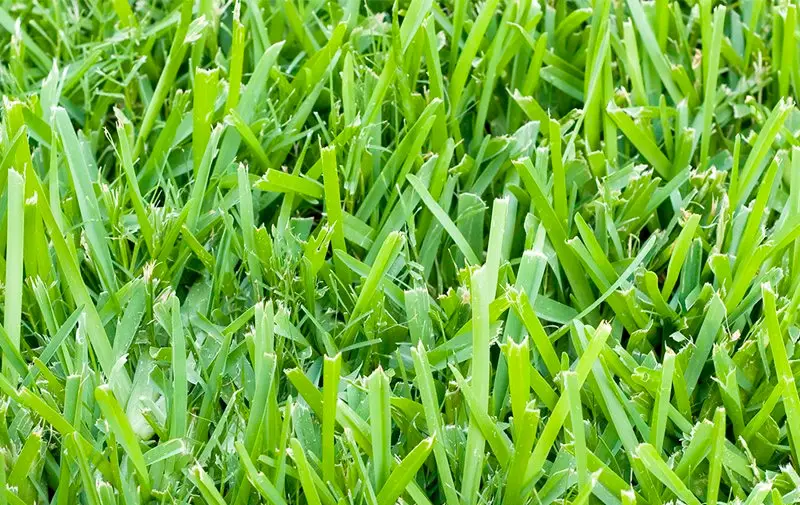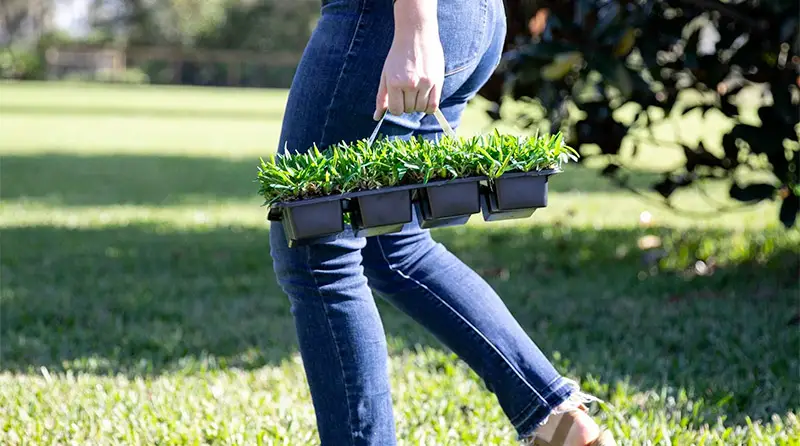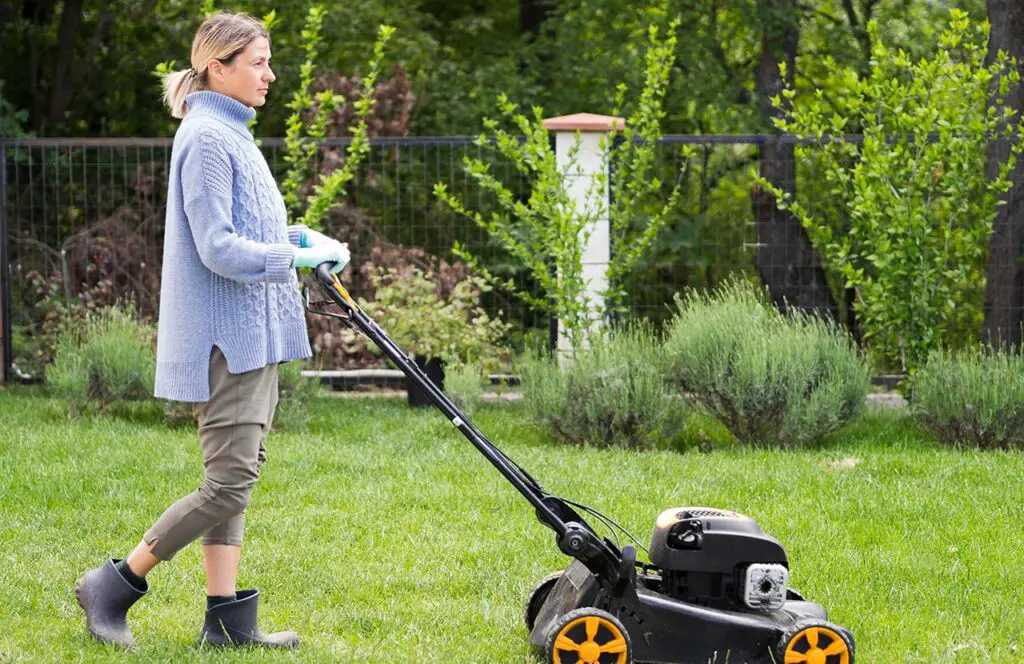How To Make St Augustine Grass Spread Quickly
St. Augustine grass is a popular choice thanks to its thick, lush appearance and ability to tolerate shade.
However, it can sometimes be slow to spread, leaving thin patches and bare spots in your yard.
To combat that, there are some methods you can use to get your St. Augustine grass spreading quickly, resulting in a healthy, full lawn.
Factors Affecting St. Augustine Grass Spread
Several things impact the growth and spread of St. Augustine grass, and knowing what they are helps you create the ideal conditions for a thriving, healthy lawn.
Here are some key factors to consider:

Soil fertility
St. Augustine grass requires adequate soil fertility to support healthy growth and spread.
Conduct regular soil tests to determine nutrient levels, pH balance, and organic matter content.
Amend the soil as needed with appropriate fertilizers, organic matter, or pH adjusters to create an optimal growing environment for St. Augustine grass.
Moisture
Consistent moisture is crucial for St. Augustine grass growth and spread.
Under-watering can cause the grass to become stressed and more susceptible to diseases, pests, and drought conditions.
On the other hand, overwatering can lead to shallow root systems, increased disease susceptibility, and other problems.
Strive to achieve a balance by watering deeply and consistently, adjusting for seasonal variations in rainfall and temperature.
Sunlight
St. Augustine grass can tolerate partial shade, but too much shade can slow its growth and spread.
In areas with insufficient sunlight, the grass may become thin, weak, and more vulnerable to pests and diseases.
Ensure that your lawn receives at least 4-6 hours of direct sunlight daily.
If your lawn has heavy shade, consider trimming back tree branches or selecting a more shade-tolerant grass variety.
Traffic
Heavy foot or vehicle traffic can compact the soil, making it difficult for St. Augustine grass to spread.
Soil compaction reduces air and water circulation, impeding root growth and overall lawn health.
Minimize traffic on your lawn whenever possible, and consider installing pathways or stepping stones in high-traffic areas to prevent soil compaction.
Aerate the soil annually to alleviate compaction and promote healthy growth.
Mowing and maintenance practices
Improper mowing and maintenance can negatively impact the growth and spread of St. Augustine grass.
Mowing too low or infrequently can weaken the grass and increase susceptibility to pests and diseases.
Follow best practices for mowing height, frequency, and maintenance to encourage optimal growth and spread.
Pests and diseases
Pests and diseases often cause considerable damage to St. Augustine grass, slowing its growth and spread.
Monitor your lawn for signs of pest infestations or disease, and address issues promptly using integrated pest management strategies or appropriate treatments.
Maintain a healthy lawn through proper watering, mowing, fertilization, and soil management to reduce the risk of pests and diseases.
Climate and weather conditions
St. Augustine grass is best suited for warm, humid climates and can struggle in areas with extreme temperature fluctuations or extended periods of drought.
While you cannot control the climate, you can take steps to mitigate its effects on your lawn.
Choose a St. Augustine grass variety that is well-suited to your region’s climate, and be prepared to adjust your lawn care practices to accommodate changing weather conditions.
By understanding and addressing these factors, you can create an environment that encourages the healthy growth and rapid spread of St. Augustine grass, resulting in a lush, vibrant lawn.
Techniques to Help St. Augustine Grass Spread Quickly

Fertilize regularly
St. Augustine grass thrives when it receives the necessary nutrients.
To encourage healthy growth and rapid spreading, apply a balanced fertilizer with a 3-1-2 ratio of nitrogen, phosphorus, and potassium every 6-8 weeks during the growing season.
Regular fertilization helps the grass maintain its vibrant color, increases its resistance to diseases, and promotes a thicker and more robust lawn.
Water properly
Consistent, deep watering is essential for St. Augustine grass growth and spread.
Water deeply once or twice a week rather than frequent shallow watering, which can lead to shallow root systems and stress the grass.
Using a sprinkler system or irrigation can ensure even watering, providing the grass with the moisture it needs to grow and spread effectively.
Aerate the soil
Compacted soil can hinder St. Augustine grass growth and spread.
Aerating the soil helps relieve compaction, improve soil drainage, and allow the grass to spread more easily.
Use a core aerator to remove small plugs of soil from the lawn, creating spaces for air, water, and nutrients to reach the grass roots.
Aerating once a year is typically sufficient for most lawns.
Mow correctly
Mowing St. Augustine grass at the proper height encourages spreading and prevents stress on the grass.
Set your mower to a height of 2-4 inches and try to avoid cutting more than one-third of the grass blade at a time.
Mowing too low can weaken the grass, making it more susceptible to diseases and pests.
Use herbicides carefully
Herbicides can help control weeds that compete with St. Augustine grass for resources, but they can also damage the grass if used incorrectly.
Follow the product label instructions carefully, and avoid applying herbicides during hot, dry weather or when St. Augustine grass is under stress.
Opt for selective herbicides that target specific weeds without harming the grass.
Plant new St. Augustine grass plugs
Planting new St. Augustine grass plugs in thin or bare areas can help fill in the gaps and promote overall lawn health.
Use a plug planter to make small holes in the soil, and then insert the plugs.
Space them 12-24 inches apart, depending on the desired coverage rate.
Overseed with ryegrass
In cooler climates, overseeding St. Augustine grass with ryegrass during the winter months can help fill in thin areas and promote overall lawn health.
Ryegrass provides a green cover throughout the colder months and can help protect the St. Augustine grass from damage due to frost and foot traffic.
Maintenance Tips for a Healthy, Spreading St. Augustine Grass Lawn

Mow regularly
Mow St. Augustine grass at the proper height and frequency to promote healthy growth and spread.
Mowing too infrequently can lead to excessive thatch buildup and make the lawn more susceptible to diseases and pests.
Water deeply and consistently
Water St. Augustine grass deeply and consistently to promote root growth and spread.
A well-hydrated lawn is more resilient to stress and better equipped to withstand pests, diseases, and environmental challenges.
Fertilize regularly
Fertilize St. Augustine grass every 6-8 weeks during the growing season to promote healthy growth and spread.
Regular fertilization ensures the grass receives the essential nutrients it needs to maintain its vitality and resilience.
Control weeds and pests
Control weeds and pests promptly to prevent damage to St. Augustine grass.
Weeds compete with the grass for resources, while pests can cause significant damage to the lawn.
Utilize integrated pest management strategies, including mechanical, biological, and chemical control methods, to keep your lawn healthy and pest-free.
Remove thatch
Thatch is a layer of dead grass, roots, and debris that accumulates between the soil surface and the living grass blades.
Excessive thatch buildup can restrict water, nutrients, and air from reaching the grass roots, hindering growth and spread.
Regularly removing thatch can promote healthy growth and spread.
Use a dethatching rake or power dethatcher to remove thatch from your St. Augustine grass lawn.
Aim to dethatch when necessary, typically once every 1-2 years, depending on the amount of thatch buildup.
Monitor and maintain soil pH
St. Augustine grass prefers a slightly acidic to neutral soil pH (between 6.0 and 7.0).
Conduct a soil test to determine the pH level of your lawn, and adjust it as needed using lime (to raise pH) or sulfur (to lower pH).
Maintaining the ideal soil pH allows your St. Augustine grass to better absorb essential nutrients and maintain healthy growth and spread.
Address lawn diseases and fungus
St. Augustine grass can be susceptible to various lawn diseases and fungal infections, which can impede its growth and spread.
Regularly inspect your lawn for signs of disease or fungal issues, such as discolored or wilting grass.
Address any issues promptly by adjusting your maintenance practices or applying appropriate fungicides, if needed.
By following these maintenance tips and utilizing the techniques to promote rapid spreading, you can cultivate a healthy, lush, and resilient St. Augustine grass lawn that will be the envy of the neighborhood.